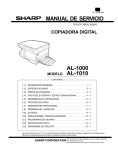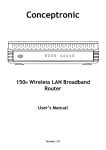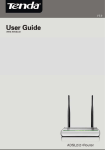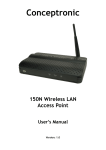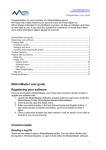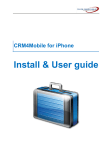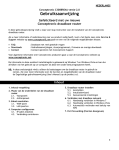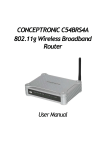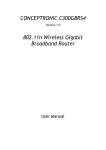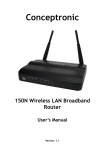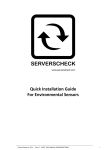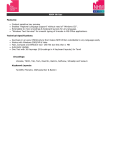Download BTRM200 User Guide
Transcript
VENTEV INNOVATIONS BTRM200 Battery Test Remote Monitoring System – User Guide V1.0 Innovations BTRM200 Battery Test Remote Monitor User Guide Contact : Ventev Innovations 10999 McCormick Road Hunt Valley, MD 21031 Phone Number 800.759.9996 Email [email protected] 1 VENTEV INNOVATIONS BTRM200 Battery Test Remote Monitoring System – User Guide V1.0 Contents 1. 2. 3. 4. Warnings...............................................................................................................................4 Supplied Accessories ............................................................................................................4 Overview...............................................................................................................................4 System Description ...............................................................................................................5 4.1. Overall System Connection Diagram.............................................................................5 4.2. System Connector Overview .........................................................................................5 5. Basic setup ............................................................................................................................6 5.1. Connecting unit to a PC.................................................................................................6 5.2. Initial Power up to set IP address..................................................................................6 5.3. Accessing your host computer’s network settings .......................................................7 5.4. Setting IP address information for BTRM default .........................................................8 5.5. Verify IP address information........................................................................................8 6. Unit Deployment ................................................................................................................13 6.1. Mounting.....................................................................................................................13 6.2. Wiring Battery Connection..........................................................................................13 6.3. Wiring Power Supply Connections ..............................................................................13 6.4. Wiring battery Charger Connections...........................................................................13 6.5. Alarm Connections ......................................................................................................13 6.6. Clearing Battery Test Data ..........................................................................................13 7. Web Interface Menus .........................................................................................................13 7.1. System Status Page .....................................................................................................14 7.2. Battery Status Page .....................................................................................................17 7.3. Battery Test Page ........................................................................................................18 7.3.1. Manual Test.................................................................................................................19 7.3.2. Capacity IO Check........................................................................................................19 7.3.3. Reset Battery Data and Setting to Defaults ................................................................19 7.4. Port Options Page ...........................................................................................................19 7.5. Email Configuration Page ............................................................................................22 7.6. Email Test Page ...........................................................................................................24 7.7. Network Configuration Page.......................................................................................24 7.8. DNP3 and Modbus ..........................................................................................................26 7.8.1. Addressing ...................................................................................................................26 7.8.2. DNP Retry Settings ......................................................................................................26 7.8.3. Communications Interface ..........................................................................................27 7.8.3.1. TCP/IP ......................................................................................................................27 7.8.3.2. RS232 .......................................................................................................................27 7.9. SNMP Configuration Page...............................................................................................27 2 VENTEV INNOVATIONS BTRM200 Battery Test Remote Monitoring System – User Guide V1.0 7.11. Help Page.....................................................................................................................30 7.12. About...........................................................................................................................31 8. SNMP Functionality ............................................................................................................31 8.2. SNMP Monitoring through a MIB Browser.....................................................................32 8.2.1. Install MIB Browser..................................................................................................32 8.2.2. Install SNMP MIB File...............................................................................................32 8.2.3. View BTRM via MIB Browser ...................................................................................33 8.2.4. Configure Trap Receiver ..............................................................................................35 8.2.5. Cannot Bind to Port 162 Error Message .....................................................................37 8.2.6. Open Trap Receiver .....................................................................................................40 8.3. Further Reading ..............................................................................................................44 9. Additional Protocols ...........................................................................................................44 9.1. DNP3 ...............................................................................................................................44 9.1.1. Overview .....................................................................................................................44 9.1.2. Data Link Layer ............................................................................................................44 9.1.3. Application Layer.........................................................................................................44 9.1.3.1. Function Support .....................................................................................................44 9.1.3.1.1. Enable Disable Unsolicited Event Status..............................................................45 9.1.3.2. Groups and Variations .............................................................................................45 9.1.3.3. Qualifiers..................................................................................................................45 9.1.3.4. Binary Input Status Points .......................................................................................45 9.1.3.5. Analog Input Status Points ......................................................................................46 9.1.3.6. Analog Output Status Points ...................................................................................46 9.1.3.7. Binary Output Status Point ......................................................................................47 9.1.3.8. Binary Output Write to Points.................................................................................47 9.1.3.9. Events ......................................................................................................................48 9.1.3.10. .....................................................................................................................................48 9.2. Mod Bus ..........................................................................................................................48 10. Additional Network Setup ..............................................................................................49 10.1. IP Reset ....................................................................................................................49 10.2. Router Ports.............................................................................................................49 10.3. Port Table.................................................................................................................50 11. Specifications and Warranty...........................................................................................50 3 VENTEV INNOVATIONS BTRM200 Battery Test Remote Monitoring System – User Guide V1.0 1. Warnings Alarm Connections 1 and 2 rated for 60 Vdc, 80 ma max load. Do not exceed these ratings. Do not connect to AC line powered loads. 2. Supplied Accessories BTRM200 Monitor 3ft Ethernet Cable 3. Overview Batteries age and their capacity slowly deteriorate until they need replacement. Also, batteries can suddenly develop an internal fault that again limits their capacity. In an AC Line Down situation, where batteries are used in critical back-up applications, these conditions will result in premature, or in some cases immediate, system shutdown. Although a battery’s state of charge can be inferred by monitoring the battery terminal voltage while in standby mode, this voltage will not give an indication of actual capacity. Furthermore, a battery that is marginal may not be detected until it is called upon to perform, at which point it is too late to prevent a system failure. For a battery connected to a charger that maintains a float voltage, neither condition can be checked. In these cases, the BTRM200 is designed to evaluate battery capacity transparently to system operation and provide network based notification should a battery fail or its capacity drop below a specified level. This also has the advantage of allowing batteries that exceed their nominal lifetime to remain in service, provided they meet capacity requirements. 4 VENTEV INNOVATIONS BTRM200 Battery Test Remote Monitoring System – User Guide V1.0 4. System Description 4.1. Overall System Connection Diagram 4.2. System Connector Overview 4.2.1. Power Supply In Power Jack (P. Source +/ - and VenCh P+) The BTRM must be connected to the load power supply in order to energize the load while the battery charger is charging the battery. 4.2.2. Battery Charger In Power Jack (VenCh B+/ -) The BTRM must be connected to the battery charger in order to charge the battery bank after the battery capacity test is performed. 4.2.3. Battery In Power Jack (Battery +/-) The battery bank must be connected directly to the BTRM in order to perform the battery capacity test. 4.2.4. Alarm Connector (Alarm1 or I/O1, Alarm2 or I/O2) BTRM has two independent, isolated relay contacts for alarm indication. Contacts are normally open when power is off. The user can select normally open or normally closed under an alarm condition. Do not exceed the contact 5 VENTEV INNOVATIONS BTRM200 Battery Test Remote Monitoring System – User Guide V1.0 maximum relay ratings of 60 Volts, 80 ma. Do not use to directly operate AC line connected equipment. 5. Basic setup 5.1. Connecting unit to a PC Notes on accessing a BTRM over Ethernet: Technically you should be able to plug the device into your current network, regardless of how your current network IP addressing is set up, and be able to reach the BTRM’s Status and Setup web page by entering its IP address (found on the BTRM front label) in a Web Browser on a local computer. However, in practice, not so easy, due to a wide variety of possibly incompatible network addressing and firewall configurations. These difficulties occur most often if someone else has set up the network settings, and in particular where these settings are “managed” by software installed on your computer by your internet provider or corporate IT departments. To avoid these potential network issues at the initial evaluation stage it is best to connect both your computer and the device to a hub/network switch (one that is not connected to the rest of your network) or directly connect your computer to the BTRM with a crossconnected Ethernet cable. 5.2. Initial Power up to set IP address To power up the device, connect the battery to the BTRM. Power up the power supply and battery charger. The BTRM starts in self-test mode for 5 to 15 seconds. PB1 and PB2 push button LEDs will blink. Once the device is power up and cabled to the Ethernet, the GREEN LED will illuminate on the Ethernet connector and startup should be complete within 30 sec. 6 VENTEV INNOVATIONS BTRM200 Battery Test Remote Monitoring System – User Guide V1.0 5.3. Accessing your host computer’s network settings From the start button select Control Panel -> Network and Internet ->Network Connections Select the adapter that you plan to use and from the File menu, select properties. This will bring up the properties window, shown on the right. Scroll down to the Internet Protocol Version 4 (IPv4) item, select it, and then select “properties”. This will bring up the window to allow manual configuration of the network adapter’s IP addresses. 7 VENTEV INNOVATIONS BTRM200 Battery Test Remote Monitoring System – User Guide V1.0 5.4. Setting IP address information for BTRM default Using a direct connection to the device with a cross connected cable or using a network switch (hub), use the manual IP settings shown on the right. This property dialog can be found in the TCP/IP properties, which is a sub dialog of the Network Connections Properties, both found in Control Panel Network Connections. (Typically the default gateway and DNS server need not be entered.) If using a router, check your local area connection settings to see if the router gateway address is the same as the default device gateway of 192.168.1.1. If it’s not, you will need to use a direct connection as described above to change the device gateway address to match the router’s gateway address. 5.5. Verify IP address information For the initial configuration of the BTRM and to change Network IP settings for placement in an IP based network you will need to connect the BTRM directly to your PC. Once connected to your PC you will be able to configure the BTRM to match your network settings. 8 VENTEV INNOVATIONS BTRM200 Battery Test Remote Monitoring System – User Guide V1.0 You will need the following information from your network administrator to add the BTRM to your IP Network: IP Address – we recommend using a static IP address for the BTRM Gateway – what is the IP address of the Gateway of your network Subnet Mask – what is the mask of your network Primary DNS – IP address of the primary DNS server for your network Once you have your connection made to you laptop or PC you will need to record your IP address and verify connection to the BTRM. NOTE: It may be necessary to give your PC or Laptop a static address to access the BTRM default network. Example: IP Address: 192.168.1.200 Subnet mask: 255.255.255.0 Use the following screen shots to guide you into finding your IP address and record your address for use later. 1. Click Start and then Run. 2. In the window type cmd and click OK. 9 VENTEV INNOVATIONS BTRM200 Battery Test Remote Monitoring System – User Guide V1.0 3. Type ipconfig then <Enter>. 4. Record your IP Address 10 VENTEV INNOVATIONS BTRM200 Battery Test Remote Monitoring System – User Guide V1.0 5. Verify connectivity to the BTRM by sending a Ping command to the BTRM’s default IP address: PING 192.168.1.214 <Enter> you should receive four REPLY messages from the BTRM. 6. Open a New Web Browser Session (Internet Explorer, Firefox or Google Chrome) and type in the address of the BTRM (default is 192.168.1.214) and click go or <enter>. If everything is set up correctly you should see the System Status of the BTRM. Note: The Status light blinks when the BTRM is active. 11 VENTEV INNOVATIONS BTRM200 Battery Test Remote Monitoring System – User Guide V1.0 12 VENTEV INNOVATIONS BTRM200 Battery Test Remote Monitoring System – User Guide V1.0 6. Unit Deployment 6.1. Mounting The BTRM needs to be mounted in a water-proof location. Typically in a cabinet with access to DC power. Use the DIN rail clip on the BTRM to secure to the DIN rail on the enclosure back plate wall. 6.2. Wiring Battery Connection Connect the battery connectors from the BTRM to the battery bank per system configuration diagram **. 6.3. Wiring Power Supply Connections Connect the BTRM power supply connections to the load power supply per system configuration diagram **. 6.4. Wiring battery Charger Connections Connect the BTRM battery charger connections to the battery charger per system configuration diagram **. ** see section 4.0 for system connection diagram 6.5. Alarm Connections Alarm connections are sets of normally open / closed contacts. These contacts are isolated from the BTRM power source, and do not provide power. They can be used to alert the Network Operations Center by connecting the alarms to your systems existing alarm signaling pairs. Alternatively, the alarm contacts can be used to operate external DC relays that then can be used to control alarm lights or audible alerts. Provided that the contact ratings (60V, 80 ma) are not exceeded. 6.6. Clearing Battery Test Data To clear test data from the BTRM memory, press and hold button PB2 for 15 seconds until the LEDs flash. 7. Web Interface Menus The BTRM will need to be configured to match your network settings as well as your email and SNMP notification if those features are to be used. See section 5 for IP addressing setup. The default Web page address of the BTRM is 192.168.1.214. Once the BTRM is connected, enter this number into your web browser. 13 VENTEV INNOVATIONS BTRM200 Battery Test Remote Monitoring System – User Guide V1.0 The Screenshots included with each sub heading will explain the different menus of the BTRM user interface. This interface allows you to remotely configure and change settings across the network. 7.1. System Status Page This screen displays an overview of the status on the BTRM. You can quickly see any alarms occur by watching this screen. 7.1.1. System Status Indicator If the web browser has a connection to the unit, the system indicator will toggle between grey and green once a second. 7.1.2. Battery Voltage This is the measurement of the battery voltage. 14 VENTEV INNOVATIONS BTRM200 Battery Test Remote Monitoring System – User Guide V1.0 7.1.3. Battery Current This is the measurement of the battery current. Negative battery current Battery is powering the load. Positive battery current Battery is being charger by battery charger. 7.1.4. Supply Voltage This is the measurement of power supply voltage. 7.1.5. System Temperature This is the measurement of the enclosure temperature. 7.1.6. Capacity This is the measurement of the battery’s capacity level. This reading is present after the first test is completed. 7.1.7. IO Channel 1 – Analog V This is the measurement of the voltage present across contact number 1. 7.1.8. IO Channel 1 – Digital In This is the logic setting for IO Channel 1 (see port options menu). TRUE The logic level voltage for the port has been met. An alarm message has been sent. FALSE The logic level voltage for the port has not been met. No alarm message has been sent. 7.1.9. IO Channel 1 – Digital Out This indicates that the IO Channel 1 relay has been set to indicate a battery relate fault (see port options menu). OFF The relay is set for normal operation. ON The relay is set to indicate a battery fault as diagnosed by the BTRM. 15 VENTEV INNOVATIONS BTRM200 Battery Test Remote Monitoring System – User Guide V1.0 7.1.10. IO Channel 2 – Analog V This is the measurement of the voltage present across contact number 2. 7.1.11. IO Channel 2 – Digital In This is the logic setting for IO Channel 2 (see port options menu). TRUE The logic level voltage for the port has been met. An alarm message has been sent. FALSE The logic level voltage for the port has not been met. No alarm message has been sent. 7.1.12. System Voltage Type Record of the voltage the system is operating at. 7.1.13. System Up Time Record of the time the system has been operational. 7.1.14. Test Status This indicates if the battery capacity test has been enabled. 16 VENTEV INNOVATIONS BTRM200 Battery Test Remote Monitoring System – User Guide V1.0 7.2. Battery Status Page 7.2.1. Capacity Test Settings Results. This field displays the time stamp for the last battery capacity test was performed, the average load current, and the average enclosure temperature the test was performed at. 7.2.2. Current Status. This field displays the estimated time to perform the battery capacity test. The test is terminated when the battery voltage goes below 11 Vdc for a 12 Vdc system or 22 Vdc for a 24 Vdc system. This is based on the battery capacity curves for lead acid batteries and the average load current of the system. The field also displays the minimum run time for the battery capacity test and the status of the last test performed. 17 VENTEV INNOVATIONS BTRM200 Battery Test Remote Monitoring System – User Guide V1.0 7.3. Battery Test Page This page is used to enable the battery capacity test and customize the test. The user can set the time between the tests and the length of the capacity test is performed. 18 VENTEV INNOVATIONS BTRM200 Battery Test Remote Monitoring System – User Guide V1.0 Manual Test Page 7.3.1. Manual Test This allows the user to manually start the battery capacity test at their discretion. 7.3.2. Capacity IO Check This allows the user to set the battery capacity level at which the test terminates. 7.3.3. Reset Battery Data and Setting to Defaults This allows the user to reset the BTRM test parameters. 7.4. Port Options Page This allows the user to enable the IO channels and the system operation voltage. 19 VENTEV INNOVATIONS BTRM200 Battery Test Remote Monitoring System – User Guide V1.0 7.4.1. IO Channel 1 7.4.1.1. Analog Input 0-32V This allows the user to enable an analog input level for triggering alarms from external sources (door switches, solid state relays, etc.). 7.4.1.2. Digital Input Alarm if < 1V This allows the user to enable a digital input logic levels that is less than 1 volt to trigger an alarm from external sources (door switches, solid state relays, etc.). 7.4.1.3. Digital Input Alarm if > 2V This allows the user to enable a digital input logic levels that is greater than 2 volt to trigger an alarm from external sources (door switches, solid state relays, etc.). 20 VENTEV INNOVATIONS BTRM200 Battery Test Remote Monitoring System – User Guide V1.0 7.4.1.4. Low Capacity Alarm This allows the user to enable the channel relay to indicate a battery relate fault Digital Out Normally Open The relay closes when a fault is indicated. Digital Out Normally Low The relay opens when a fault is indicated. 7.4.2. IO Channel 2 7.4.2.1. Analog Input 0-32V This allows the user to enable an analog input level for triggering alarms from external sources (door switches, solid state relays, etc.). 7.4.2.2. Digital Input Alarm if < 1V This allows the user to enable a digital input logic levels that is less than 1 volt to trigger an alarm from external sources (door switches, solid state relays, etc.). 7.4.2.3. Digital Input Alarm if > 2V This allows the user to enable a digital input logic levels that is greater than 2 volt to trigger an alarm from external sources (door switches, solid state relays, etc.). 7.4.3. System Voltage Allows the user to select whether the system operates at 12 V or 24 V. 21 VENTEV INNOVATIONS BTRM200 Battery Test Remote Monitoring System – User Guide V1.0 7.5. Email Configuration Page This page allows the user to configure information needed for the BTRM to access an email server and deliver messages to the destination email address along with two customizable text strings to provide additional situation detail in the email alert. 7.5.1. Contact and Location While these text strings that are included with outgoing email and SNMP notifications to aid in identifying the site location and manager, they can be used for any purpose. Contact: Enter the name of the contact person responsible for the site. Location: Enter a short description of the site location the BTRM is monitoring 22 VENTEV INNOVATIONS BTRM200 Battery Test Remote Monitoring System – User Guide V1.0 The following information should be obtained from your Network Administrator to setup the SMTP server. 7.5.2. Port Enter the Port number the SMTP server uses, select SSL if it uses Secure Socket Layer. Normally this port is 25. For secure servers other port numbers are typically used such as Secure SMTP (SSMTP) - port 465 and Secure IMAP (IMAP4SSL) - port 585. 7.5.3. User name and Password If you are using your dedicated IP provider’s internet service and its email server you will likely leave these two items blank. If you are on a public network, most likely you will need to access a secure server using SSL. In this case the user name and password will likely be required. 7.5.4. Server Address This is the IP address or IP name of your outgoing email server. For example Gmail’s server is smtp.gmail.com 7.5.5. Destination Email Address The BTRM will send the email notifications to this email address. 23 VENTEV INNOVATIONS BTRM200 Battery Test Remote Monitoring System – User Guide V1.0 7.6. Email Test Page Use this page to send a test email using the setting from the previous page. If successful after several seconds, the web page will update to indicate that the message has been successfully sent. If the page does not refresh after a minute, then likely the message was not sent. Check you setting, and or try these setting using a laptop and its email client to verify the connection and settings. 7.7. Network Configuration Page This screen allows you to configure the Network settings on the BTRM. DO NOT change any of the settings here unless you know what you are doing. These settings should be configured under the direction of your network administrator. 24 VENTEV INNOVATIONS BTRM200 Battery Test Remote Monitoring System – User Guide V1.0 Multiple BTRM’s could be active in the network at the same time. Each will have its own IP address to allow for remote access and monitoring. To access any BTRM in the network, open a web browser and type the IP address of the BTRM into the address bar. Each BTRM should have their own unique address when they are part of the same network. 7.7.1. Host Name This name can be used in place of the IP address to get access to the BTRM. 7.7.2. IP address, Gateway, Subnet Mask Enter the settings to match your network system. 25 VENTEV INNOVATIONS BTRM200 Battery Test Remote Monitoring System – User Guide V1.0 7.8. DNP3 and Modbus Selection and setup of DNP3 and Modbus Master and BTRM Device addresses and communications protocol selection. 7.8.1. Addressing Master and Device addressing supports values between 0 and 65535. Confirm with your selected protocol what address values are allowable. 7.8.2. DNP Retry Settings Retry settings for unsolicited messages range between 0 (no retries) and 254 with setting of 255 causing continuous retries. Elapsed time between retries 0 to 255 seconds (settings below 5 seconds not recommended). 26 VENTEV INNOVATIONS BTRM200 Battery Test Remote Monitoring System – User Guide V1.0 7.8.3. Communications Interface 7.8.3.1. TCP/IP Configurable :TCP/IP Port (Default 20000) Configurable: TCP/IP Unsolicited message destination IP address 7.8.3.2. RS232 BTRM supports a 3 wire RS232 using standard connections on DB9 connector. Baud Rates: Selectable 9600, 19200 Format: Data 8 bits, No Parity, Stop Bits 1 7.9. SNMP Configuration Page Setting the community strings provides SNMP with basic password protection. User has a choice of 3 read only and 3 write only strings. Most SNMP browsers are configured to use the typical default strings, public, read, or write. When a string is changed read or write, the software used to connect to the BTRM must also use the same strings for read write access. If you wish to use SNMP alerts the Read and Write strings will need to be configured to match your network. These settings should only be changed by a Network Administrator or by someone who understands the proper settings for your network. Leaving a field blank will disable it. 27 VENTEV INNOVATIONS BTRM200 Battery Test Remote Monitoring System – User Guide V1.0 NOTE: SNMP configurations may be confusing. Please consult your Network Administrator to assist you in the SNMP configuration and setup. 28 VENTEV INNOVATIONS BTRM200 Battery Test Remote Monitoring System – User Guide V1.0 7.10. SNMP MIB File Page The BTRM is provided with a Management Information Base File (a text file ending in “.mib”). This file allows a MIB browser to translate the numeric OID numbers into text descriptions. This can be down loaded in the MIB browser from the BTRM firmware using this webpage. 29 VENTEV INNOVATIONS BTRM200 Battery Test Remote Monitoring System – User Guide V1.0 7.11. Help Page This page provides the user default IP and SNMP notification setup information. 30 VENTEV INNOVATIONS BTRM200 Battery Test Remote Monitoring System – User Guide V1.0 7.12. About This page provides the user with web page and firmware revision information. 8. SNMP Functionality 8.1. Network SNMP Monitoring Simple Network Management Protocol (SNMP), used by most Network Operations Centers (NOC), is a protocol that allows the NOC to retrieve parameters, set parameters, and receive Alert Notifications from Ethernet connected appliances though a common interface and language. Each network appliance feature, that can be read or written to, will have a numeric string assigned to it. For example system description (sysDesc) is .1.3.6.1.2.1.1.1.0. 31 VENTEV INNOVATIONS BTRM200 Battery Test Remote Monitoring System – User Guide V1.0 For Network SNMP functionality, consult your network administrator for SNMP setup and configuration parameters and how the BTRM should be configured for your specific SNMP requirements and trap receivers. 8.2. SNMP Monitoring through a MIB Browser In order to accept SNMP messages being sent from the BTRM you will need to have an SNMP monitoring system in your network or a MIB browser loaded onto your laptop. A MIB browser can be used to capture SNMP traps in place of a network SNMP trap receiver. The MIB Browser can be loaded onto a PC or Laptop for monitoring of BTRM SNMP Traps. The MIB browser will need to be on the same network as the BTRM in order to receive the messages. SNMP network access can be had from interfaces as simple as a command line interface available in Windows, Linux, and other operating systems, or using a dedicated software browser like the one shown below from iReasoning, available at www.iReasoning.com, to larger packages such as HP Openview designed to support and manage larger networks. IMPORTANT: Once the MIB Browser is loaded you will need to load the BTRM MIB file. You can down load the BTRM MIB file from the BTRM via the SNMP MIB file page on you web browser. 8.2.1. Install MIB Browser 1. Download MIB Browser from http://www.ireasoning.com. 2. Open MIB Browser Folder. 3. Click on the Setup.exe file. 4. Click Run and Follow the installation instructions. 5. Click Close when the installation has completed. 6. Launch the MIB Browser. 8.2.2. Install SNMP MIB File 1. In the MIB Browser – Click on the File Tab. 2. Select Load MIBs. 3. In the Open Window, locate the file called btrm2_mib_yyyy-mm-dd.mib (This traps file should be located in the software files included with your BTRM). 4. Click on the btrm2_mib_yyyy-mm-dd.mib. 5. Click Open. 32 VENTEV INNOVATIONS BTRM200 Battery Test Remote Monitoring System – User Guide V1.0 8.2.3. View BTRM via MIB Browser 1. Once the MIB browser is loaded, click on the desktop icon to launch it. You will see the main screen that should look similar to the one below. In the Address field type in the IP address of the BTRM, 192.168.1.214. Expand the folders on the left menu and highlight private. 2. If you have changed the community strings from the default values, use the advanced menu item to update the browsers read write community strings to match the BTRM. 33 VENTEV INNOVATIONS BTRM200 Battery Test Remote Monitoring System – User Guide V1.0 3. From the operations pull down menu, select “Walk” and click Go. 34 VENTEV INNOVATIONS BTRM200 Battery Test Remote Monitoring System – User Guide V1.0 4. You should see data results begin to fill up in the main window Results Tab. 8.2.4. Configure Trap Receiver In order to receive SNMP Traps (alert messages) you will need to setup your MIB browser to receive them. This means you need to setup your TrapReceiver so that the BTRM knows where to send the traps. So in the next you will setup the TrapReceiver IP address. (You will set this to the IP address of your laptop that you recorded earlier). 35 VENTEV INNOVATIONS BTRM200 Battery Test Remote Monitoring System – User Guide V1.0 1. In the Results Table locate the line that says trapReceiverAddress.0 , right click on the line and select “set”. 36 VENTEV INNOVATIONS BTRM200 Battery Test Remote Monitoring System – User Guide V1.0 2. Enter the IP Address of your PC or Laptop in the Value field and click OK. Note: In order to receive SNMP messages the BTRM and the associated PC or Laptop must be on the same network or be able to communicate across networks. Verify connectivity by pinging the BTRM with your PC or laptop. If you receive a reply you should be able to receive SNMP messages. 3. If your entry was successful you will see a SET succeeded window. 8.2.5. Cannot Bind to Port 162 Error Message Depending on your computer configuration you may get an error message pop up that says that you cannot bind to port 162. SNMP uses port 162 and sometimes Windows has an active SNMP server running that is using port 162. If you get this message you will need to follow the steps below to kill the process using the port. 37 VENTEV INNOVATIONS BTRM200 Battery Test Remote Monitoring System – User Guide V1.0 Steps to shut down Application binding to Port 162 1. Load CurrPorts software – Download CurrPorts software from http://download.cnet.com/CurrPorts. 2. Click on the cports.exe icon to launch the software 3. When the software opens click Run. 4. Locate the application that is using port 162 by finding it under the Local Port column. Click on the line to highlight it. 38 VENTEV INNOVATIONS BTRM200 Battery Test Remote Monitoring System – User Guide V1.0 5. Right click on the highlighted line (ensure you are on the line of the process using port 162) select “Kill Processes Of Selected Ports” 39 VENTEV INNOVATIONS BTRM200 Battery Test Remote Monitoring System – User Guide V1.0 6. Select Yes on the window that asks if you want to kill the process. 7. You should now be able to return to the MIB browser and continue to open the Trap Receiver. 8.2.6. Open Trap Receiver 1. In order to see the SNMP alert messages coming in you will need to open the trap receiver Tab. To do this, in the MIB Browser, go to Tools and select Trap Receiver. 40 VENTEV INNOVATIONS BTRM200 Battery Test Remote Monitoring System – User Guide V1.0 2. You should now see a Trap Receiver Tab in the main window of the MIB Browser. 3. Now, in order to see the SNMP traps coming in you need to throw the BTRM into an alarm by removing one contact loop circuit at a time. There are various ways to break the contact loop circuit depending on the BTRM configuration. a. Door Switch i. Push the door switch in and hold for approximately 10 seconds. This simulates the enclosure door beeing closure. ii. Release the door switch. iii. In a few seconds you should see an SNMP message alert come into the trap receiver in the MIB Browser. b. AC/DC OK Indication i. When you remove the AC power from the enclosure, you should see an alarm on the BTRM. 41 VENTEV INNOVATIONS BTRM200 Battery Test Remote Monitoring System – User Guide V1.0 ALSO NOTE: The software alarms in the BTRM user interface and the SNMP alert messages, the BTRM is also sending out email message alerts to the email address that you configured in the email setup section. 42 VENTEV INNOVATIONS BTRM200 Battery Test Remote Monitoring System – User Guide V1.0 Sreenshot of the System Status Screen showing alarm on IO Channel 1. The Digial In “TRUE” logic level indicates that the voltage thrush hold for the port has been met. An alarm message has been sent. 43 VENTEV INNOVATIONS BTRM200 Battery Test Remote Monitoring System – User Guide V1.0 Screenshot of SNMP Messages showing alarm on IO Channel 1. If you click on the SNMP messages you can read the detailed description including timesstamp and location the message was sent from. 8.3. Further Reading Douglas Mauro, Kevin Schmidt. Essential SNMP, Second Edition. O'Reilly Media, Inc. 9. Additional Protocols 9.1. DNP3 9.1.1. Overview 9.1.2. Data Link Layer BTRM2 DNPV2.0 Currently no support for data link layer commands 9.1.3. Application Layer 9.1.3.1. Function Support Dec 0 1 2 Hex 0 1 2 Function Confirm Read Write 44 VENTEV INNOVATIONS BTRM200 Battery Test Remote Monitoring System – User Guide V1.0 5 13 15 20 21 129 130 5 D F 14 15 81 82 Direct Operate Cold Restart Initialize Data Enable Unsolicited Disable Unsolicited Response Unsolicited Response 9.1.3.1.1. Enable Disable Unsolicited Event Status BTRM allows enable and disable of unsolicited events. Status can be read from Binary Point 3 9.1.3.2. Object /Group 01 30 10 10 40 41 60 60 Groups and Variations Object /Group Binary Input Status Analog Input Status Binary Output Status Binary Output Write Analog Output Status Analog Output Class 1 Static Data Class 2 Event Data 9.1.3.3. Variation 02 04 02 01 02 02 01 02 Description 1 byte input status with flag 16 bits without flag 1 byte output status with flag Write using q00 start = stop 16 bits with flag 16 bits with flag 0x01 Class 1 Data Class 2 Data Qualifiers Qualifiers (Hex) 00 06 17 9.1.3.4. Type Static Static Static Static Static Static Static Static Used In a request a range of points or single point all points range and index 8 bits list of unrelated points Range 8 bits 8 bits 8 bits Index 8 bits 8 bits 8 bits Binary Input Status Points Point 0 1 2 3 4 5 Description Low Battery Capacity Low Battery Voltage DNP3 Unsolicited Enabled Aux IO Channel 1 Digital In Aux IO Channel 2 Digital In Any Fault Flag 45 State Low Low Enabled Tripped Tripped Tripped Value 0x81 0x81 0x81 0x81 0x81 0x81 VENTEV INNOVATIONS BTRM200 Battery Test Remote Monitoring System – User Guide V1.0 9.1.3.5. Point 0 1 2 3 4 5 6 7 8 9 10 11 9.1.3.6. Point 0 1 2 3 4 5 Analog Input Status Points Description Battery Voltage Charger Voltage Battery Current Temperature Battery Minimum Runtime Battery Runtime Estimate Battery Test Temperature Battery Test Schedule Time Battery Test Next Time Aux IO Channel 1 Voltage Aux IO Channel 2 Voltage Firmware Version Units millivolts 0 to3200 mv millivolts 0 to3200 mv ±milliamps ± 32000 ma ±°C Minutes 0 to 3200 minutes Hours ±°C Hours 0 to 500 Hrs Hours 0 to 500Hrs millivolts 0 to3200 mv millivolts 0 to3200 mv format xx.xx -> 130 = v1.30 Analog Output Status Points Description Battery Minimum Runtime Battery Test Schedule Time Battery Test Next Test Time Aux IO Channel 1 Config Aux IO Channel 2 Config System Selection 12V /24V State Minutes Hours Hours 1,2,3 1,2,3,4,5 1,2 46 0 to 3200 minutes 0 to 500Hrs 0 to 500Hrs (see below) (see below) 1= 12v, 2 =24v VENTEV INNOVATIONS BTRM200 Battery Test Remote Monitoring System – User Guide V1.0 IO1 Function Control Read Group 40 Variation 2 Direct Operate Direct Op Value Group 41 Variation 2 Values 0,1,2,3,4 16bit Analog with flag 16bit Analog with flag 0 Analog 1 Digital Input Alarm if < 1v 2 Digital Input Alarm if > 2v Low Capacity Alarm 3 Digital Out NC 4 Digital Out NO IO2 Function Control Read Group 40 Variation 2 Direct Operate Direct Op Value Group 41 Variation 2 Values 0,1,2 16bit Analog with flag 16bit Analog with flag 0 Analog 1 Digital Input Alarm if < 1v 2 Digital Input Alarm if > 2v 9.1.3.7. Point 0 1 2 3 Binary Output Status Point Description Battery Data Reset Battery LVD Status Battery Test Enable Battery Start Test 9.1.3.8. State Session has Data LVD is enabled Test is enabled Test running Value 0x81 0x81 0x81 0x81 State Data Empty LVD disabled Test is disabled Test not running Value 0x01 0x01 0x01 0x01 Binary Output Write to Points Binary output points can be written to directly using Group 10 variation 01, using Qualifier 0x00 (8 bit index and range). Points must be written to individually, using matching start and stop values, followed by the binary value "1" or "0" (See DNP_IEE-1815-2023 11.9.4.6) 47 VENTEV INNOVATIONS BTRM200 Battery Test Remote Monitoring System – User Guide V1.0 To clear or enable write a "1", or to disable write a "0". An xample to reset battery data, g10v01 q00 start 0 stop 0 value 1, would be to issue an application layer write command of the form: c5 02 0a 01 00 00 00 01 Point 0 1 2 3 Description Battery Data Reset Battery LV Disconnect Enable Battery Test Enable Battery Start / Stop Test State Write to Enable Write to Clear Write to Start Write to Start Value 0x81 0x81 0x81 0x81 State Write to Disabled Cleared Write to Stop Write to Stop Value 0x01 0x01 0x01 0x01 9.1.3.9. Events When Events are generated, they are reported via unsolicited messaging (if enabled), or queue to the event list for reading when polling for Class 2 data, or reading Binary events. Event points correspond to Binary Input Points. Point 1 2 4 5 Description Low Battery Capacity Event Low Battery Voltage Event Aux IO Channel 1 Event Aux IO Channel 2 Digital In 9.1.3.10. 9.2. Mod Bus - expected Q3/2013 48 State Tripped Event Tripped Event Tripped Event Tripped Event Value 0x81 0x81 0x81 0x82 VENTEV INNOVATIONS BTRM200 Battery Test Remote Monitoring System – User Guide V1.0 10. Additional Network Setup 10.1. IP Reset To reset the device to its default IP address settings, hold Button PB1 for 20 seconds. All the LEDs will flash and the unit will restart with the default IP settings listed on the device label. Typically these settings are: Unit IP 192.168.1.214 Subnet Mask 255.255.255.0 Gateway 192.168.1.1 10.2. Router Ports If you need to access the device from outside of a local intranet (hosts computer is on the WAN side of the device router), the appropriate ports will need to be set on the router to which the host computer is attached and also the router to which the device is attached. One solution Routers allow a single device to be set so that it can be reached by using the router’s IP address. The same can be done for the host computer, sometimes called –“placing the device in the demilitarized zone” (DMZ). Not as secure, but much simpler as ports do not need to be forwarded. In this case the device IP the Router WAN IP. Opening Ports Method When accessing the device from behind a router the device LAN IP address is effectively hidden. In this case the port number is used to determine the final destination.. Only the WAN IP address of the router is reachable. The host computer then uses the router WAN IP as the destination IP address. The Router then uses the messages destination port, and the routers port forwarding table to direct to the appropriate device on the internal intranet. For example: Host Computer has internal LAN IP of 192.168.1.214 Its Router has WAN IP of 100.78.60.21 Device issues a SNMP notification to 100.78.60.21:162 (where 162 is the port number) 49 VENTEV INNOVATIONS BTRM200 Battery Test Remote Monitoring System – User Guide V1.0 The Router is the message destination. The Router looks at the message’s port, checks its port forwarding table to see if the UDP port 162 is forwarded to a local LAN IP address. If so, delivers it to that IP address (in this case the Host Computer), otherwise the message is discarded. 10.3. Port Table Function Web Page Access (http) SNMP Management Access SNMP Notifications Email DNP3 Firmware Update Default Port Values TCP/IP UDP 80 161 162 21 20000 16384 11. Specifications and Warranty Electrical Specifications Operating Voltage Battery Max Current Charger Max Current Load 1 & 2 Combined Max Current 9 to 32 VDC 10 A Continuous 10 A Continuous 10 A Continuous Battery and Charger Voltage Measurement Current Measurement 0 to 32V ± 1% 0 to 10 Amps ± 1% Environmental Temperature Humidity -20° C to +60° C 5 % to 95% Non Condensing Mechanical Size Weight Mounting 6.25” H X 2.8” D X 1.2” W 5.0 oz (142 g) Din rail mounting Warranty One Year 50 VENTEV INNOVATIONS BTRM200 Battery Test Remote Monitoring System – User Guide V1.0 Note: Specifications subject to change without notice. 51



















































